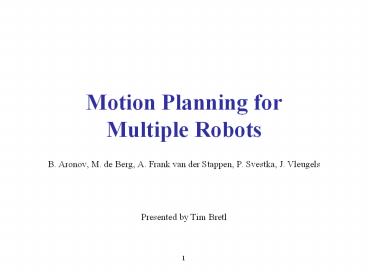Motion Planning for Multiple Robots PowerPoint PPT Presentation
Title: Motion Planning for Multiple Robots
1
Motion Planning forMultiple Robots
- B. Aronov, M. de Berg, A. Frank van der Stappen,
P. Svestka, J. Vleugels - Presented by Tim Bretl
2
Main Idea
- Want to use centralized planning because it is
complete. - ProblemDimension of planning space is very
large. - SolutionConstrain relative positions of robots
to reduce the dimension of the planning space
while maintaining completeness.
3
Assumptions (1)
- n Number of obstacles in the workspace.
- N Number of robots in the workspace.
- All robots and obstacles have constant complexity.
4
Assumptions (2)
- Using an existing, deterministic path planner
(Basu et al.) to generate roadmaps with
complexity O(nD1), where D is the total number
of dimensions of the configuration space.
Reduce D to reduce planning complexity!
5
Outline
- Two-Robot Planning
- Three-Robot Planning
- N-Robot Planning
- Bounded-Reach Robots
- Summary and Problems
6
Two-Robot Planning
Example Translational Motion, Arbitrary Relative
Position
y
y
x
D12
x
D22
Total DOF D1D2 4
7
Constrained Planning (1)
Example Translational Motion, Enforced Contact
y
?
x
D12
D2,c1
Total DOF D1D2,c D1D2-1 3
8
Constrained Planning (2)
Example Translational Motion, One Robot
Stationary
y
D2,s0
x
D12
Total DOF D1D2,s D1D2-2 2
9
Constrained Planning (3)
- Define a permissible multi-configuration as
- Robot 1 stationary at start or goal (DOFD2)
- Robot 2 stationary at start or goal (DOFD1)
- Robots 1 and 2 in contact (DOFD1D2-1)
- Maximum DOF is D1D2-1
- If we could plan using only permissible
multi-configurations, DOF could be reduced by one
10
Lemma
- If a feasible plan exists for two robots, then a
feasible plan exists using only permissible
multi-configurations.
11
Example (1)
12
Example (2)
13
Coordination Diagram
0
2
1
4
5
3
6
7
14
Coordination Diagram
Nominal Multi-Path
Arbitrary Feasible Multi-Path
Multi-Paths Using Only Permissible
Multi-Configurations
15
Example (1)
(Using only permissible multi-configurations)
16
One Subtlety
- Still need to connect the spaces of permissible
multi-configurations with discrete transitions
CS1,s Robot 1 stationary at start
position CS1,g Robot 1 stationary at goal
position CS2,s Robot 2 stationary at start
position CS2,g Robot 2 stationary at goal
position CScontact Robots moving in contact
17
Transitions (1)
CS1,s
CS2,s
Easy
CS1,g
CS2,g
Hard
CScontact
18
Transitions (2)
- Calculating transitions to/from CScontact is
hard, because there is a continuum of possible
transitions.
- Example Solution Method for CS1,s
- Divide CS1,s into connected cells
- Each cell is bounded by a number of patches
- For each patch that corresponds to contact
configurations, take an arbitrary point on the
patch as a transition point
19
Main Result
- Algorithm
- Compute a roadmap for each of the five
permissible multi-configuration spaces - Compute a complete representative set of
transitions between these spaces - Gives a roadmap for the complete problem
- Can be computed in order O(nD1D2) time
20
Extension to Three Robots (1)
Example Translational Motion, Enforced Contact
y
?1
?2
x
D12
D2,c1
D3,c2
Total DOF D1D2,cD3,c D1D2D3-2 4
21
Extension to Three Robots (2)
- Permissible Multi-Configurations
- (k0,1,2) robots moving in contact
- (2-k) robots stationary at either start or goal
positions
22
Extension to Three Robots (2)
- Main result is analogous O(nD1D2D3-1)
- More difficult to prove
Coordination diagram now has three dimensions.
23
Extension to N Robots
- Divide the robots into three groups
- 2 single robot groups
- 1 multi-robot group containing N-2 robots
- Now the result for three robots applies, reducing
DOF by two - It is not known whether a stronger result
(analogous to that for two and three robots) can
be shown (reducing DOF by N)
24
Bounded-Reach Robots
- Low-density environment
- Bounded-reach robot
Total planning time is O(n log n) (Van der
Stappen et al.)
25
Low-Density Environment
- For any ball B, the number of obstacles C of size
bigger than B that intersect B is at most some
small number ?.
26
Bounded-Reach Robot
- The reach R of a robot is the radius of the
smallest ball completely containing the robot
regardless of configuration. - A robot with bounded-reach has a reach that is a
small fraction of the minimum obstacle size.
27
Multi-Robot Reach (1)
- ProblemA multi-robot does not have bounded-reach
28
Multi-Robot Reach (2)
- SolutionPermissible multi-configurations do have
bounded-reach and can represent the entire
planning space
Total planning time (for two or three robots) is
O(n log n)
29
Summary
- Paper gives a useful algorithm for a small
reduction in DOF for complete, centralized
multi-robot planning - The results are even better for bounded-reach
robots in low-density environments
30
Problems
- Mainly useful for answering yes/no connectivity
questions for real robots, you probably want to
avoid contact configurations - Plans are not optimal (in fact, are usually far
from optimal)

